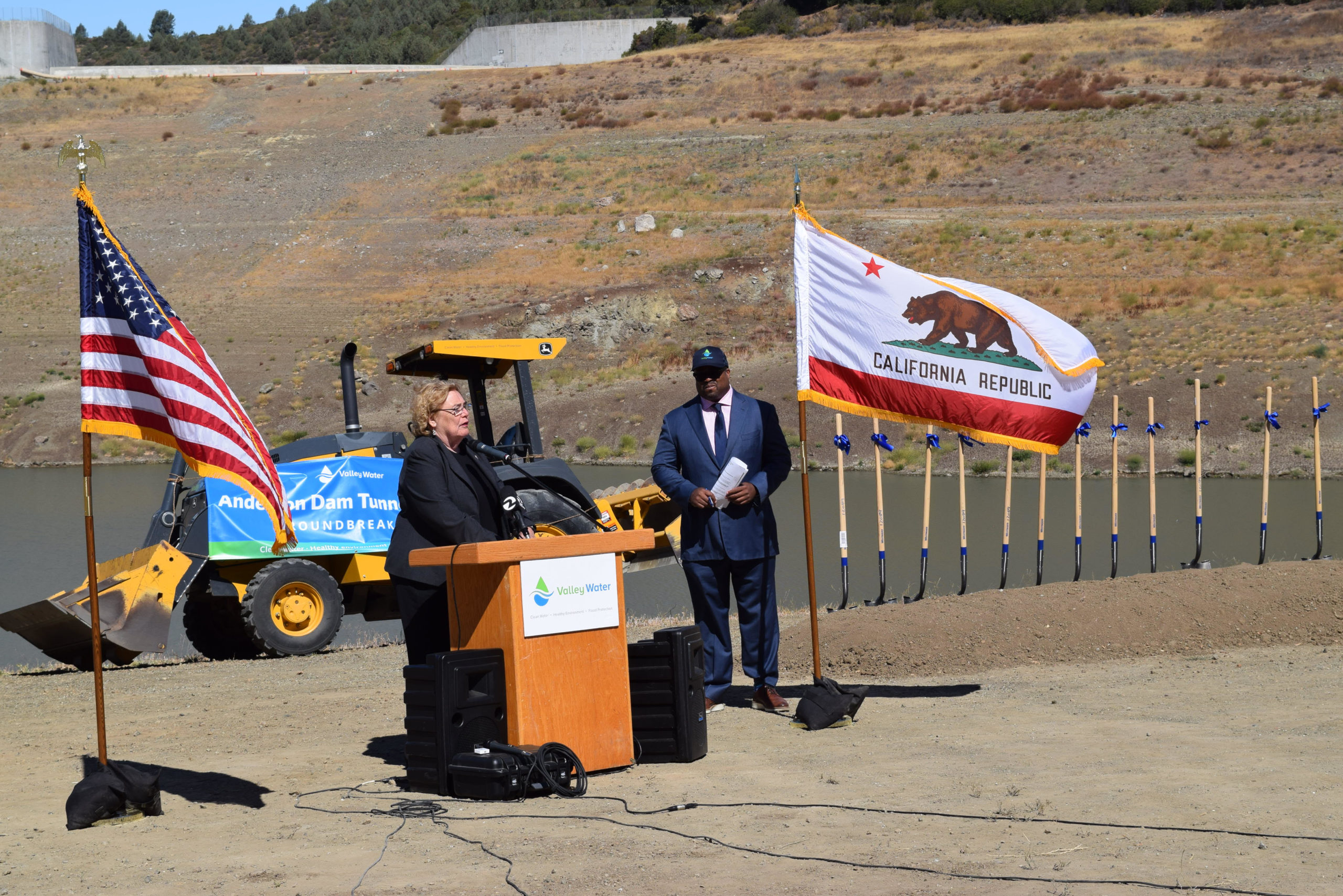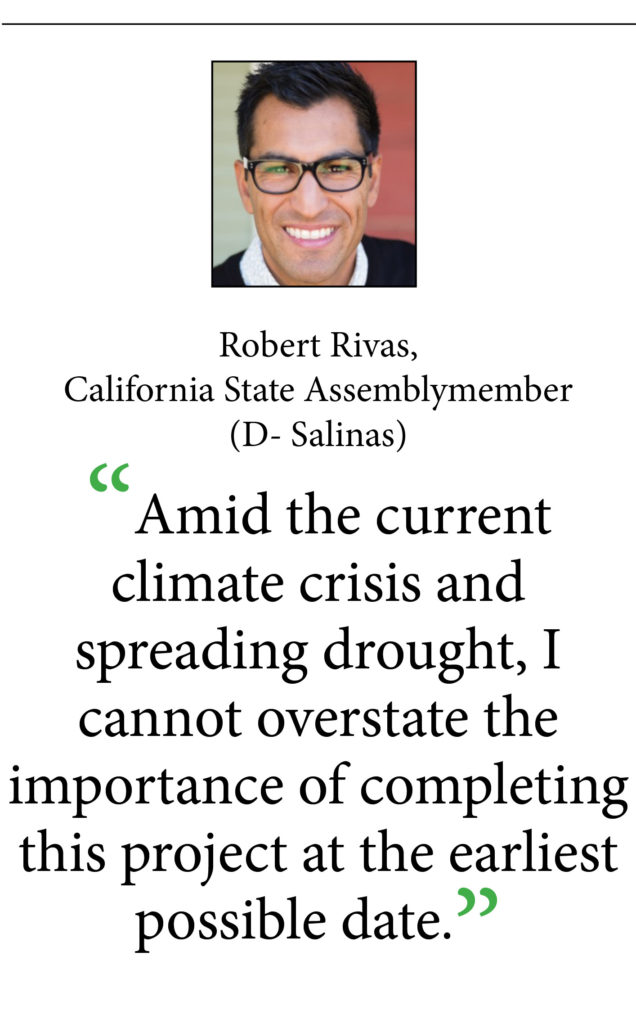Project will cost $648 million, take 10 years
![]()

Photo by Kaylee Arca
Congresswoman Zoe Lofgren (D – San Jose) and Valley Water Chief Executive Officer Rick Callender during the July 7 groundbreaking
ceremony launching the seismic retrofit project of Anderson Dam.
By Kaylee Arca
After years of planning, dirt will soon start flying on the rebuilding of Anderson Dam. The seismic retrofit project will cost about $648 million with the intention to prevent a massive flooding of South Valley and locations north if a major earthquake were to destroy the dam.
 Local leaders met at the dam the morning of July 7 for a ground-breaking ceremony to start the first phase: the construction of an overspill outlet tunnel on the southside of the dam’s embankment. This tunnel will take about five years to build and cost an estimated $162 million. The tunnel will safely control the release of rising reservoir water during major storms.
Local leaders met at the dam the morning of July 7 for a ground-breaking ceremony to start the first phase: the construction of an overspill outlet tunnel on the southside of the dam’s embankment. This tunnel will take about five years to build and cost an estimated $162 million. The tunnel will safely control the release of rising reservoir water during major storms.
The tunnel excavation will start in late fall or early winter.
“We are getting the project up and going,” said Rick Callender, Valley Water CEO, at the ceremony. “This is the start of a very long project, but we will get this done.”
Anderson Reservoir sits atop two fault lines. Experts estimate a magnitude 7.25 earthquake on the Calaveras Fault centered less than 1.25 miles from the dam, or a magnitude 6.6 earthquake on the Coyote Creek Fault centered beneath the dam, could significantly damage the embankment and lead to failure and a massive flood. This wall of water could kill thousands of people and destroy homes and other property. Such a catastrophe is not possible now because at the end of 2020 the dam was drained to 3 percent of its capacity.
The lake created by Anderson Dam is a fill-and-spill reservoir. When it’s full, the spillway and outlet tunnel is used to safely drain excess water to help prevent overflowing and flooding.
Flooding caused by large rainstorms has occurred at least 10 times since the dam’s construction in 1950. The last time overflow measures were used was in 2017, causing the Coyote Creek to flood some neighborhoods in San Jose.
“The last time I was here at the dam (four years ago), water was rushing over the top in a flood that impacted Morgan Hill,” said Congresswoman Zoe Lofgren who represents South Valley. “We looked more closely at what would happen if there was an earthquake when the dam was full. Now that’s catastrophic. There would be a wall of water in Morgan Hill in 14 minutes.” The flood would also hit downtown Gilroy in less than an hour.
Engineers discovered seismic stability issues in Anderson Dam in 2011. Project planning began in 2012, but federal dam safety regulations and negotiations between government agencies caused the design portion of the seismic retrofit project to take seven years.

Photo by Kaylee Arca
Anderson Dam is currently at 3 percent capacity while a new tunnel is built, but will be completely drained to retrofit the new dam. The project is expected to take about a decade.
The Federal Energy Regulatory Commission ordered Valley Water to drain Anderson Reservoir starting Oct. 1, 2020. Valley Water drained the reservoir to 3 percent of its capacity. It will remain at this level during the tunnel’s construction. Water will then be completely drained for five more years as the wall of the dam is dismantled and rebuilt.
Anderson Reservoir is the largest in Santa Clara County and can hold about 90,000 acre-feet of water. When full, it can supply nearly one million people with water for a year.
Valley Water faces challenges with California now in a major drought, low rainfall levels the past two winters, and the loss of Anderson Reservoir to store water for the next 10 years. Its engineers have found ways to make sure water is supplied to its customers, the various cities in the county.
 “We’re trying to move along recycled water projects, recharge groundwater aquifers and purchase imported water,” Callender said.
“We’re trying to move along recycled water projects, recharge groundwater aquifers and purchase imported water,” Callender said.
A large portion of groundwater is being pulled from aquifers so there is now enough water supply for the county, said Chris Hakes, deputy operating officer for dam safety.
“We have a diverse portfolio between groundwater and imported water,” he added.
Valley Water has a budget of $20 million this year to import water into Santa Clara County. However, the rest of drought-stricken California is also chasing down water supplies, Callender said. The water district must work around regulations and share water supplies with other counties.
“Conservation is a way of life. Recycled water is a way of life,” Callender said. “We have to fix the dam and get it done.”
 Leaders at Valley Water ask county residents to decrease their water usage by 15 percent of their 2019 water usage. People can achieve this by taking shorter showers, watering lawns less and other conservation methods.
Leaders at Valley Water ask county residents to decrease their water usage by 15 percent of their 2019 water usage. People can achieve this by taking shorter showers, watering lawns less and other conservation methods.
“Water is life. It’s critical,” Callender said.
Gov. Gavin Newsom signed Assembly Bill 271 July 9 authorizing Valley Water to move quickly in hiring contractors to ensure the project is completed on time and to high standards. Assemblymember Robert Rivas (D-Salinas), who represents South Valley, authored the bill.
“Amid the current climate crisis and spreading drought, I cannot overstate the importance of completing this project at the earliest possible date,” Rivas said in a press release. “Given the seriousness and complexity of the project, AB 271 will allow Valley Water to pick the best firm to construct this project, not the cheapest.”
Kaylee Arca, a 2017 graduate of Sobrato High School, recently graduated from San Diego State University with a degree in Journalism and Media Studies.






